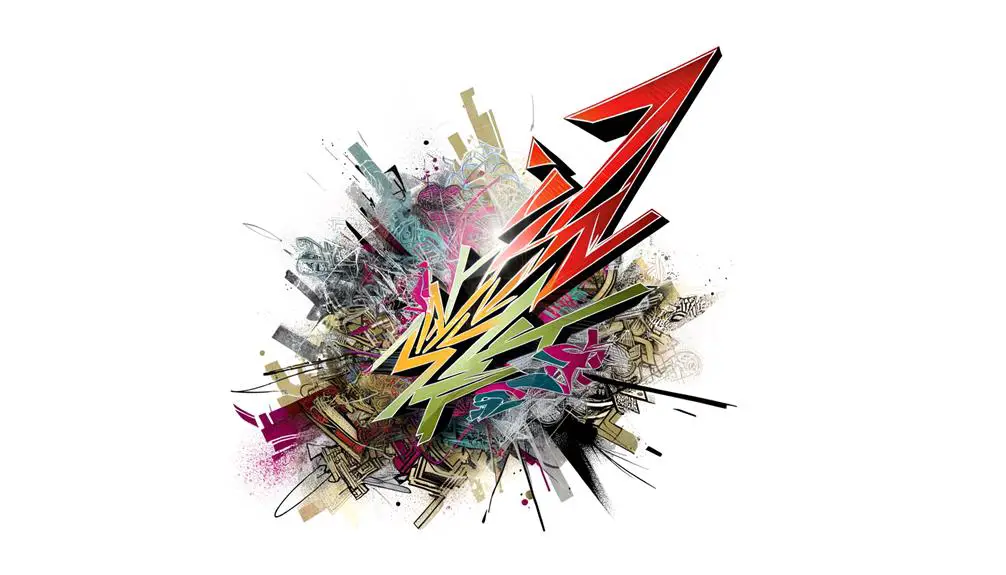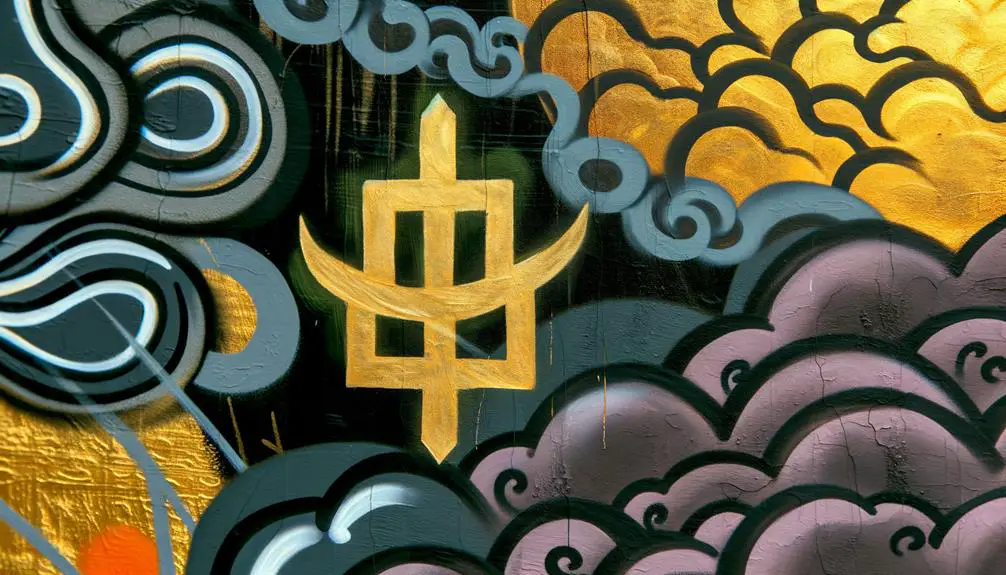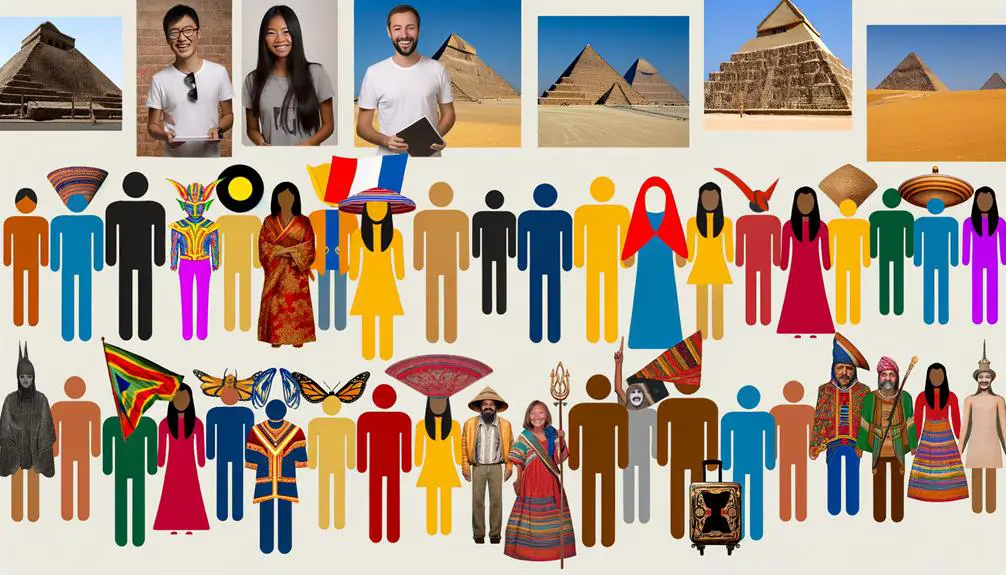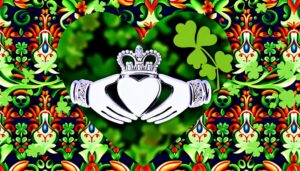Decoding the Meaning of the Wu Tang Symbol
The Wu-Tang symbol, conceived by the Wu-Tang Clan in the early 1990s, represents unity, strength, and resilience within hip-hop culture. The emblem, inspired by martial arts iconography, reflects the group's philosophical and cultural principles.
It underscores collective strength, cohesion, and shared struggles, mirroring the discipline and tactical acumen rooted in martial arts. Over time, the symbol has evolved, capturing the group's growth and enduring influence.
Beyond its musical impact, it has shaped fashion and global hip-hop narratives, standing as a powerful cultural icon. To grasp the deeper layers of its significance, consider the intricate blend of themes it represents.

Key Takeaways
- The Wu-Tang symbol represents unity, strength, and resilience, reflecting the group's collective ethos.
- It draws inspiration from martial arts, symbolizing discipline, self-mastery, and philosophical depth.
- The stylized 'W' embodies the group's journey and their unique identity within hip-hop culture.
- The symbol has evolved over time, capturing the group's growth and enduring influence.
- Globally recognized, it signifies the Wu-Tang Clan's impact on music, fashion, and cultural narratives.
Origins of the Symbol

Originating from the creative vision of the Wu-Tang Clan, the iconic Wu-Tang symbol was conceptualized in the early 1990s as a representation of the group's unique identity and cultural influence. This period marked a significant transformation in the hip-hop landscape, with the Clan aiming to distinguish themselves within an increasingly competitive industry.
The symbol not only encapsulated their gritty, raw aesthetic but also symbolized their collective strength and unity. Rooted in the martial arts themes that permeated their music and philosophy, the emblem became a visual shorthand for their ethos.
The symbol's creation coincided with the group's rise to prominence, effectively branding their revolutionary sound and solidifying their place in hip-hop history.
The Design Process

The design process of the Wu Tang symbol is rooted in a blend of conceptual inspiration sources and meticulous iteration.
By analyzing the artistic influences and strategic decisions that shaped its iconic logo, one can appreciate the thoughtful evolution from initial sketches to its final form.
This examination reveals how the emblem encapsulates the group's identity and cultural impact.
Conceptual Inspiration Sources
Drawing from a rich tapestry of cultural, historical, and artistic influences, the design process behind the Wu Tang symbol embodies a meticulous blend of conceptual inspiration sources. The emblem resonates with elements from martial arts iconography, ancient Chinese symbolism, and hip-hop culture, creating a powerful visual identity. The designers sought to encapsulate the group's ethos and stylistic essence by merging these diverse elements.
| Inspiration Source | Cultural Significance | Emotional Impact |
|---|---|---|
| Martial Arts Iconography | Discipline and Strength | Empowerment and Resilience |
| Ancient Chinese Symbols | Heritage and Wisdom | Reverence and Contemplation |
| Hip-Hop Culture | Rebellion and Innovation | Unity and Resistance |
This synthesis reflects the Wu Tang Clan's commitment to authenticity and depth in their artistic expression.
Iconic Logo Evolution
Undergoing a transformative journey, the Wu Tang symbol's iconic logo evolution encapsulates a dynamic interplay of artistic ingenuity and cultural resonance.
Initially conceived by DJ Mathematics, the logo's design process involved a meticulous blend of sharp angles and fluid curves, mirroring the group's raw yet harmonious musical style.
The emblem's evolution reflects the collective's growth from underground pioneers to global icons. Subtle refinements over time have enhanced its visual impact, ensuring it remains relevant and instantly recognizable.
Contextually, the symbol's adaptation paralleled shifts in the hip-hop landscape, serving as a visual anchor amid changing trends.
This deliberate, iterative design approach underscores the Wu Tang Clan's commitment to preserving their legacy while embracing contemporary cultural currents.
Symbolism and Themes

Central to the Wu Tang symbol are profound themes of unity, strength, and resilience, which reflect the collective ethos of the iconic hip-hop group. The symbol, a stylized 'W', embodies the group's commitment to cohesion amidst diversity, symbolizing their collective power.
This unity is further underscored by their shared struggles and triumphs, mirroring the resilience necessary to thrive in the face of adversity. The emblem's sharp lines and bold design convey an unyielding strength, resonating with the group's lyrical content that often speaks to overcoming societal challenges.
Therefore, the Wu Tang symbol is not merely a logo but a representation of the group's philosophical and cultural principles, encapsulating their journey and ethos in a powerful visual form.
Influence of Martial Arts

The Wu Tang Clan's emblem and ethos are deeply influenced by martial arts, reflecting themes of discipline, strategy, and philosophical depth that permeate both their music and visual identity. This influence is evident in the group's adoption of martial arts terminology, imagery, and philosophy.
Rooted in the ancient wisdom of Eastern martial traditions, the Wu Tang symbol embodies concepts such as self-mastery, resilience, and tactical acumen. The group's name itself is derived from the Wudang Mountains, renowned for their association with Taoist martial arts.
This martial arts influence transcends mere aesthetics, shaping the group's creative processes and narrative structures, infusing their work with a profound sense of purpose and intricacy.
Connection to Hip-Hop Culture

The Wu Tang symbol's origins in New York's gritty urban landscape provided a fertile ground for its integration into hip-hop culture, reflecting the genre's raw and authentic ethos.
This iconic emblem has greatly influenced fashion, becoming a staple in streetwear and a marker of cultural identity.
In addition, the symbol embodies the group's unique fusion of music, martial arts, and philosophical narratives, cementing its place as an enduring icon in hip-hop history.
Origins in New York
Rooted in the vibrant boroughs of New York City, the Wu-Tang Clan emerged as a seminal force in hip-hop culture during the early 1990s. Hailing primarily from Staten Island, their unique blend of gritty street narratives and martial arts-inspired imagery set them apart from contemporaries.
The group's formation in 1992 marked a pivotal moment, driven by a collective vision spearheaded by RZA, their de facto leader and producer. Wu-Tang's raw, unfiltered sound resonated deeply with the urban experience, capturing the socio-economic struggles and aspirations of inner-city life.
This authenticity and innovative approach not only solidified their status in the hip-hop pantheon but also made their iconic 'W' symbol a lasting emblem of resilience and artistry.
Influences on Fashion
As the Wu-Tang Clan's influence permeated hip-hop culture, it naturally extended into the world of fashion, where their distinctive aesthetic left an indelible mark.
The group's embrace of streetwear staples such as oversized hoodies, baggy jeans, and Timberland boots became emblematic of East Coast hip-hop style.
Their bold use of the Wu-Tang symbol on apparel not only created a visual identity but also fostered a sense of community among fans.
This crossover was instrumental in bridging the gap between music and fashion, leading to collaborations with major brands and solidifying the Wu-Tang Clan's impact.
Their fashion choices were not mere trends but a reflection of the urban experience, resonating deeply within the culture.
Symbol and Identity
Embodying the essence of hip-hop culture, the Wu-Tang symbol has transcended its origins to become a powerful emblem of identity and unity within the community. This iconic logo, with its bold and simplistic design, encapsulates the rebellious spirit and innovative artistry of hip-hop.
Its significance stems from several key factors:
- Cultural Unification: The symbol represents a collective identity, bringing together diverse individuals under a shared ethos.
- Artistic Innovation: It highlights the group's creative approach, blending martial arts imagery with urban aesthetics.
- Enduring Legacy: Its continued relevance underscores the lasting impact of Wu-Tang Clan's music and philosophy.
These elements collectively position the Wu-Tang symbol as a cornerstone of hip-hop's visual and cultural narrative.
Meaning of the "W" Shape

The iconic 'W' shape of the Wu Tang Clan symbol is a meticulously crafted representation that encapsulates the group's identity, cultural influence, and the martial arts ethos they embody. Its sharp, angular design evokes a sense of strength and resilience, mirroring the raw, unapologetic nature of the group's music.
The 'W' is also reminiscent of a bird in flight, symbolizing freedom and ascension, core principles in both hip-hop culture and martial arts philosophy. This duality of meaning underscores the group's ability to transcend conventional boundaries, merging urban street life with the disciplined art of combat.
Through its visual simplicity and profound symbolism, the 'W' stands as a powerful emblem of unity, defiance, and artistic expression.
Evolution Over Time

The Wu-Tang Clan's emblem has undergone significant transformations since its inception, reflecting both the group's evolving identity and its profound cultural impact.
Early logo designs were raw and minimalist, capturing the gritty essence of their music; however, modern adaptations have expanded in depth and style, symbolizing their enduring influence.
A thorough examination of these changes reveals not only the adaptability of the symbol but also its role as a cultural icon in contemporary society.
Early Logo Designs
In its nascent stages, the Wu-Tang Clan's logo underwent several iterations that reflected the group's evolving identity and artistic vision. Initially, the logo was a rudimentary sketch, capturing the raw energy and street ethos of the group.
As the group's artistic direction matured, so too did the sophistication of the logo design. This evolution can be categorized into three primary stages:
- Initial Sketches: Early designs were simplistic, emphasizing the gritty, underground nature of the group.
- Refinement Phase: The logo saw enhancements in detail, incorporating more intricate elements to symbolize the group's complex lyrical themes.
- Finalized Icon: The iconic 'W' took its definitive shape, blending sharp edges with fluid motion to encapsulate Wu-Tang Clan's unique blend of hardness and fluidity.
This progression mirrored the group's growth and their increasing influence in the music industry.
Cultural Impact Analysis
Wu-Tang Clan's emblematic 'W' has transcended its origins as a mere logo to become a powerful cultural symbol, reflecting the group's enduring influence on music, fashion, and global hip-hop culture.
Initially, the 'W' served as a unifying mark for the collective's innovative sound and rebellious ethos. Over time, it has evolved into an icon of authenticity and resilience, representing the group's rise from Staten Island's gritty streets to global stardom.
The symbol's proliferation in diverse contexts—from streetwear to academic discourse—underscores its broad cultural resonance. This evolution illustrates how the 'W' encapsulates the essence of Wu-Tang's legacy, serving as a tribute to their revolutionary impact on cultural narratives and identity within and beyond the hip-hop domain.
Modern Symbol Adaptations
Adapting to the shifting landscapes of contemporary culture, the emblematic 'W' has been reinterpreted through various artistic and commercial lenses, reflecting its dynamic resonance across multiple spheres. The Wu Tang symbol's evolution mirrors its enduring influence and adaptability, engaging new audiences while preserving its foundational significance.
Particularly, modern adaptations include:
- Fashion Collaborations: High-profile partnerships with streetwear brands, such as Supreme and HUF, have infused the 'W' into contemporary fashion.
- Digital Media: The symbol has found a resurgence in digital art and NFTs, bridging the gap between traditional hip-hop culture and modern technology.
- Merchandising: Limited edition products ranging from sneakers to skateboards showcase the symbol's versatility and market appeal.
These adaptations underscore the symbol's enduring legacy and relevance.
Cultural Impact

The Wu-Tang Clan's symbol has transcended its origins in hip-hop to become a potent icon within various cultural spheres, symbolizing resistance, creativity, and the power of collective identity. Its impact is evident across multiple domains, from fashion to visual arts, and even academia. The symbol's adoption by diverse groups underscores its universal resonance and adaptability. Below is a table highlighting key areas influenced by the Wu-Tang symbol:
| Domain | Example | Significance |
|---|---|---|
| Fashion | Streetwear brands | Symbol of urban culture |
| Visual Arts | Graffiti and murals | Expression of rebellion and identity |
| Academia | Cultural studies programs | Subject of scholarly analysis |
| Film & TV | Cameos and references | Cultural relevance and homage |
| Merchandise | Clothing and accessories | Commercial success and brand loyalty |
This table encapsulates the symbol's broad cultural impact and its enduring legacy.
Fan Interpretations

Among fans, the Wu-Tang symbol is often seen as a potent emblem of unity, resilience, and cultural pride. This iconic logo goes beyond mere branding, capturing deeper meanings unique to each admirer.
Importantly, fan interpretations can be classified as follows:
- Unity: Many fans perceive the symbol as a portrayal of collective strength and camaraderie, reflecting the group's ethos of solidarity.
- Resilience: Others see it as a reflection of overcoming adversity, embodying the challenges and victories of the Wu-Tang Clan.
- Cultural Pride: For some, the symbol represents a tribute to heritage and identity, resonating deeply within the realm of hip-hop culture.
These interpretations underscore the diverse impact of the Wu-Tang symbol, solidifying its status as a revered icon among its fanbase.
Global Recognition

As the Wu-Tang Clan's influence extended far beyond the confines of Staten Island, their symbol achieved global recognition, becoming an emblem of hip-hop culture worldwide.
The iconic 'W' logo transcended its origins, symbolizing not just the group, but the resilience and creativity inherent in hip-hop. This recognition is rooted in the Wu-Tang Clan's innovative music and their impact on fashion, media, and popular culture.
Their collaborations with international artists and brands further solidified their global footprint. The symbol's adoption by diverse fan bases across continents highlights its universal appeal, reflecting a shared cultural understanding that bridges geographic and social divides.
Therefore, the Wu-Tang symbol stands as a tribute to the group's enduring legacy and global influence.
Conclusion
The Wu-Tang symbol, a beacon of cultural synthesis, intertwines martial arts iconography with the pulsating rhythm of hip-hop. Emerging from a meticulous design process, it encapsulates themes of strength, unity, and defiance.
Its evolution mirrors the group's enduring influence, transcending music to leave a global imprint. Like a river carving through stone, the symbol's impact flows through diverse cultural landscapes, resonating with fans and symbolizing a powerful convergence of artistic expression and identity.






